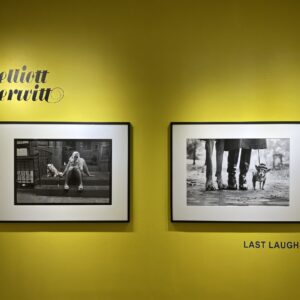JTF (just the facts): A total of 12 photographic works, framed in dark wood and unmatted, and hung against white walls in the main gallery space and the smaller back room. 9 of the works are cured inkjet on wood, made in 2019 or 2020. These works are sized between roughly 32×73 and 97×49 inches, and each is unique. The other 3 works on view are archival pigment prints on wood veneer, made in 2010. These works are sized roughly 31×24 inches and are available in editions of 12. (Installation shots below.)
Comments/Context: Reinterpretation is a topic worth more study by photographic historians. Most often we think about image reinterpretation in the context of a photographer printing a negative one way when it was first made, and somewhat differently years later, perhaps heightening or softening areas of contrast, using different papers and chemicals which subtly alter the tones of the resulting prints, or changing the scale (usually getting larger). Sometimes the artistic rationale behind the change of process or mood is communicated, especially if there is a bold break with the past, but more often it is simply hidden in the details and chalked up to the evolving preferences of the artist.
While this show of new works by Clifford Ross doesn’t include any of his earlier photographs for handy comparison, it is essentially an exploration of reinterpretation, but of a more dramatic kind than straightforward reprinting. Starting with his own images of hurricane waves and Mount Sopris in Colorado, Ross has variously cropped, reversed the tonalities, and enlarged the source imagery, significantly changing the dynamics (and the proportions) of the compositions. He has then taken the unusual step of printing the edited black-and-white photographs on thin panels of wood veneer, and between the grain of the wood and the subtle tan coloring of the wood itself, the resulting works hardly feel like photographs at all.
Ross’s original wave photographs (as seen, for example, in a 2009 gallery show, reviewed here) were deliberately wide, taking in the horizontal planes of the wave and the separation of sky, water, cresting wave, froth, and runout to the beach. In these new works, Ross has reversed that geometry, turning the waves into tall thin vertical slices, much like Japanese or Chinese screens. The exceptional detail of the originals is still present, but the stacked bands of light and dark are more pronounced in this cropped orientation. Most of the compositions alternate back and forth between light and dark layers as they move from top to bottom, with areas of sparkling spray giving way to dark undercurrents and foamy bubbles of white. The grain of the wood moves vertically, creating indistinct lines that cross against the textures of the waves, adding a subtle sense of natural vitality. As reinterpretations, the drama and the celebration of the power of nature found in the original photographs are still present, but the presentation feels more intimate than before, the natural substrate giving the waves a softer, more reverently tactile feel.
The other works in the show use Ross’s extra high resolution image of Mount Sopris and its surroundings as their source (Ross hand built the R1 camera that made the image, and at the time, the resulting picture was one of the highest resolution landscape photographs ever made). Each new work has been cropped down to just a tiny fragment of the larger original, many to be found along the lake’s edge, where the dense forest is reflected in the water. Again, the influence of Asian scrolls and multi-panel screens is evident, with images cut into tall and thin slices that feel elongated (especially when long tree trunks are mirrored by the lake), and the printing on wood softens the crispness of the resolution just a bit, adding to the feeling of delicacy. In all of these landscape views, Ross has inverted the tonalities of light and dark, making them even more ethereal and ghostly, and the wood-on-wood effect is more congruent here than in the wave scenes, the natural panels giving the pictures a further sense of understated tactile grace.
What’s conceptually interesting about what Ross has done with these works is that he has deliberately cut against their originally perceived strengths – both the waves and the mountain views were astonishing for their unprecedented technical clarity, and yet, in this presentation, the wood base doesn’t allow visual sharpness to be the defining feature. Instead, the images drift into more indistinct territory, where they become almost timeless, especially when the compositions are tightened down to views that mimic traditional landscape forms. The warm wood surface provides the equivalent of sepia toning, without looking mannered or forced, allowing Ross to aesthetically reach back to the past, while still leveraging his experimental present. Not only are these new works technically smart, they now have an elemental richness and subtlety that was often overlooked in the originals.
Collector’s POV: The unique works in this show are priced at either $35000 or $40000, based on size, while the smaller editioned works are $10000 each. Ross’s works have only been intermittently available in the secondary market in the past decade, with prices ranging between roughly $5000 and $33000.











